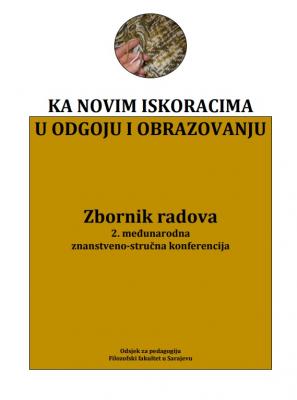KULTIVIRANJE ESTETSKOG I KULTURNOG SENZIBILITETA UČENIKA VIŠIH RAZREDA OSNOVNE I SREDNJE ŠKOLE
CULTIVATING THE AESTHETIC AND CULTURAL SENSIBILITY OF STUDENTS IN THE UPPER GRADES OF PRIMARY AND SECONDARY SCHOOLS
Author(s): Nela HasanbegovićSubject(s): Museology & Heritage Studies, Visual Arts, Aesthetics, School education, Educational Psychology, History of Art, Pedagogy
Published by: Filozofski fakultet Univerziteta u Sarajevu
Keywords: communication; artworks; visual culture and arts classes; critical thinking; perception; reception; development of divergent thinking; student;
Summary/Abstract: Visual culture and fine arts have an integral and comprehensive role in different aspects of life, as well as in shaping the identity of every human being. As a specifically human spiritual and material activity, visual/fine arts are constituted in a complex communication process, establishing links between individual and social cognitions. All of these facts are presumed for the quality integration of future generations into the social and cultural currents of time and space in which they live. By adopting a visual language and meta-language, students would acquire the competence to comprehend a complex visual environment, contexts and concepts of artworks, and artistic strategies. Moreover, they would be qualified for the critical judgment and valorization of artworks. A student’s communication with an original artwork, or with a quality reproduction of it results in the cultivation of his/her aesthetic sensibility, which is also a precondition for his/her active participation in shaping a new visual reality. Some postmodern and contemporary artworks require direct communication and interaction, and can only be perceived as such in their natural environment (museums, galleries, or public spaces). These characteristics of visual/fine arts requires the redefining of teaching strategy and the teaching process in the classroom, with the main goals to enable students’ abilities for personal perception of artworks and their full experience of and reflection on them. After an analyis of the relevant sources, it can be concluded that in the teaching process of the subject of visual culture and arts, the Visual Thinking Strategy (VTS), which is necessary for achieving a high quality and level in the teaching process, is rarely used, while such courses in our educational system are mostly conducted in classrooms with the help of reproductions, neglecting the benefits of using a VTS approach in such alternative spaces as museums and galleries.
Journal: Zbornik radova Odsjeka za pedagogiju
- Issue Year: 2/2018
- Issue No: 2
- Page Range: 374-381
- Page Count: 8
- Language: Bosnian

